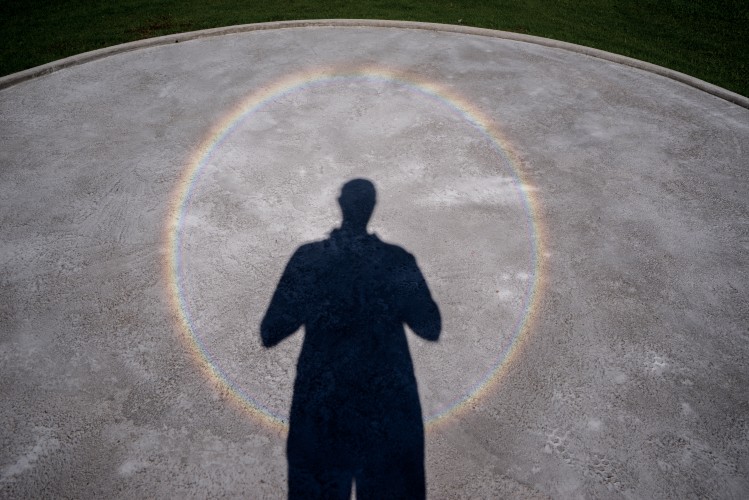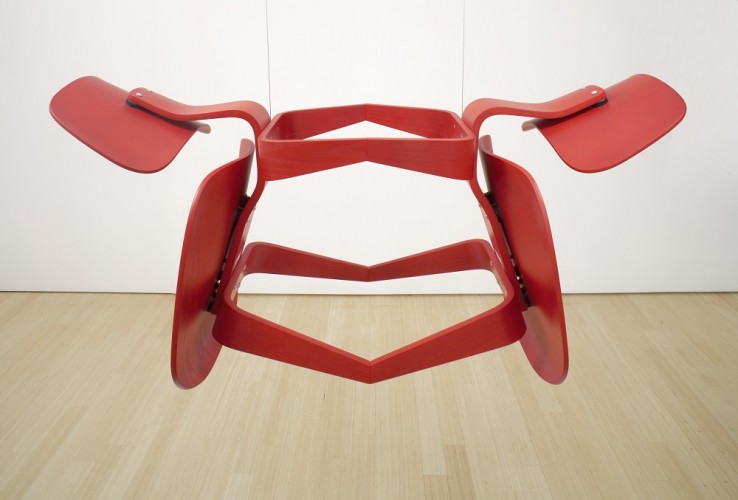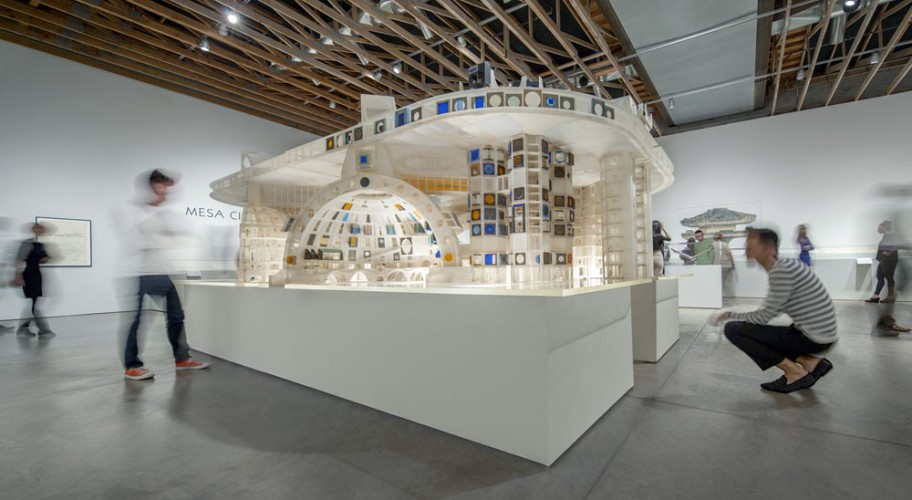
Paolo Soleri, Arcosanti, 1969. Plexiglas, adhesive and acrylic paint, 72 × 96 × 132 inches (two sections). Courtesy of the Cosanti Foundation. Photo: Bill Timmerman
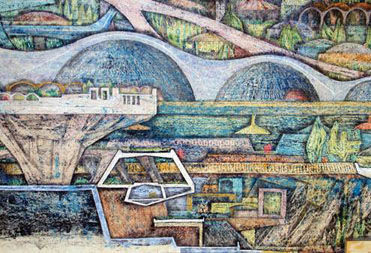
Paolo Soleri, detail, Macro-Cosanti Foundation Studies 2 and 3, 1964. Pastel, pencil, china ink, charcoal and color chalk on paper with gauze backing, 48 x 527 inches. Collection of the Cosanti Foundation. © Cosanti Foundation. Photo: Cosanti Foundation/Soleri Archives/David DeGomez
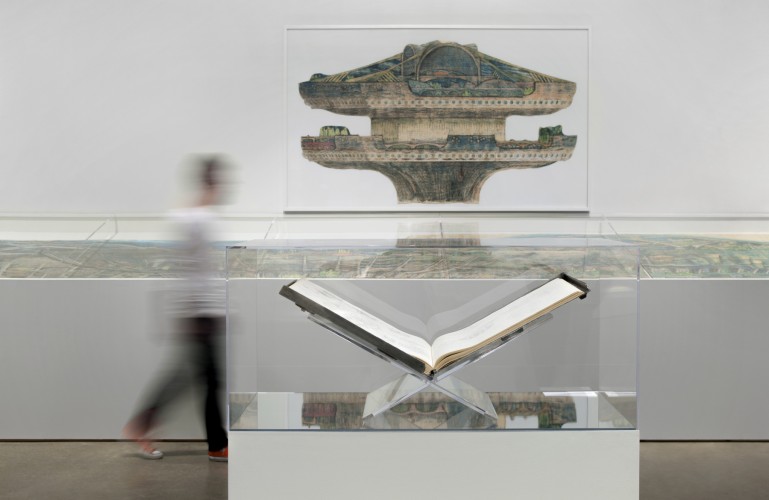
Installation view, Paolo Soleri: Mesa City to Arcosanti, on view at the Scottsdale Museum of Contemporary Art, 2013. Photo: Bill Timmerman
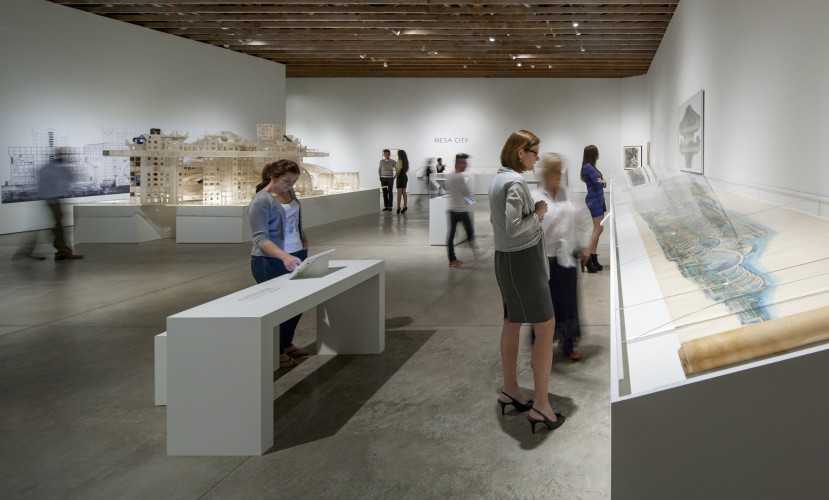
Installation view, Paolo Soleri: Mesa City to Arcosanti, on view at the Scottsdale Museum of Contemporary Art, 2013. Photo: Bill Timmerman
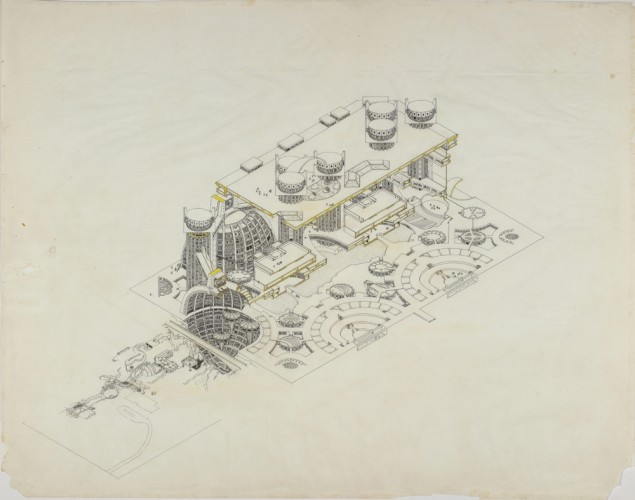
Paolo Soleri, detail, Macro-Cosanti Foundation Studies 2 and 3, 1964. Pastel, pencil, china ink, charcoal and color chalk on paper with gauze backing, 48 x 527 inches. Collection of the Cosanti Foundation. © Cosanti Foundation. Photo: Cosanti Foundation/Soleri Archives/David DeGomez Paolo Soleri, Arcosanti, 1968. Ink and yellow crayon on paper, 32 x 38 inches. Collection of the Cosanti Foundation. © Cosanti Foundation. Photo: Cosanti Foundation/Soleri Archives/David DeGomez
Paolo Soleri
Paolo Soleri: Mesa City to Arcosanti
PAOLO SOLERI (1919 – 2013) It is with deep sadness that the Scottsdale Museum of Contemporary Art joins Arizona and the larger global community to acknowledge the passing of Paolo Soleri on April 9, 2013. Soleri will be missed by all those fortunate enough to have known him. His thinking, his architecture and his art will […]
Jan 26 - Apr 28, 2013
PAOLO SOLERI (1919 – 2013)
It is with deep sadness that the Scottsdale Museum of Contemporary Art joins Arizona and the larger global community to acknowledge the passing of Paolo Soleri on April 9, 2013. Soleri will be missed by all those fortunate enough to have known him. His thinking, his architecture and his art will continue to challenge us to create a better world.
In 2010, SMoCA initiated a series of three exhibitions exploring the trajectory of Paolo Soleri’s art, architecture and philosophy. Paolo Soleri: Mesa City to Arcosanti is the second in the series. This exhibition begins in the early 1960s when Soleri shifted his focus from bridges and residences to large-scale urban planning based on environmental accountability. Soleri’s first comprehensive vision of a community is Mesa City, an example of what he calls an “arcology,” or an architectural project based on the synthesis of architecture + ecology. The second design—Macro-Cosanti—followed quickly in 1964. Soleri imagined it as an expanded, or macro, version of Cosanti, his first residence and studio located in nearby Paradise Valley. The name Cosanti is a fusion of two Italian words, cosa (“things”) and anti (“against”). Cosanti represents the micro city, and Macro-Cosanti the larger, more expansive one. Finally, a number of drawings and models represent Soleri’s earliest designs for Arcosanti (arcology + Cosanti), a town built in the 1970s in Mayer, Arizona.
While other 20th-century experiments in high-density communities—for example, Le Corbusier’s Unité d’habitation (1947 – 52) built in Marseilles, France, or Frank Lloyd Wright’s plan for a mile-high Chicago skyscraper, The Illinois (1956)—Soleri’s designs address low-density urban and suburban sprawl and focus on the city’s relationship to the natural world and environmental accountability. In his prolific drawings, Soleri imagined vibrant urban spaces created by high-density urban living, respect for natural resources and a commercial sector based upon creativity. The proposed high-rise buildings provide square footage on a smaller footprint. Pedestrian-friendly parks and gardens link the elements of a vibrant city center—private residences, stores, schools, markets, churches, hospitals, libraries, theaters and museums. These are conceptual drawings, not construction blueprints. They are intended to demonstrate layouts and configurations as a starting point for architects, engineers and sociologists.
Soleri’s architectural drawings appear in the form of sketchbooks and uninterrupted drawings on long rolls of butcher paper. On display is a very early design of Mesa City on a scroll from 1959. Another drawing, measuring over 40 feet long, is a bright, imaginative illustration of Macro-Cosanti. Here Soleri’s aesthetic style shines through in brilliant colors and delicate detail. An immense model depicts Soleri’s first three-dimensional imaginings of Arcosanti. It was previously exhibited at the Corcoran Museum of Art and the Whitney Museum of American Art in the 1970s before construction the larger, moreexpansive one. Finally, a number of drawings and models represent Soleri’s earliest designs for Arcosanti (arcology + Cosanti), a town built in the 1970s in Mayer, Arizona.
While other 20th-century experiments in high-density communities—for example, Le Corbusier’s Unité d’habitation (1947 – 52) built in Marseilles, France, or Frank Lloyd Wright’s plan for a mile-high Chicago skyscraper, The Illinois (1956)—Soleri’s designs address low-density urban and suburban sprawl and focus on the city’s relationship to the natural world and environmental accountability. In his prolific drawings, Soleri imagined vibrant urban spaces created by high-density urban living, respect for natural resources and a commercial sector based upon creativity. The proposed high-rise buildings provide square footage on a smaller footprint. Pedestrian-friendly parks and gardens link the elements of a vibrant city center—private residences, stores, schools, markets, churches, hospitals, libraries, theaters and museums. These are conceptual drawings, not construction blueprints. They are intended to demonstrate layouts and configurations as a starting point for architects, engineers and sociologists.
Soleri’s architectural drawings appear in the form of sketchbooks and uninterrupted drawings on long rolls of butcher paper. On display is a very early design of Mesa City on a scroll from 1959. Another drawing, measuring over 40 feet long, is a bright, imaginative illustration of Macro-Cosanti. Here Soleri’s aesthetic style shines through in brilliant colors and delicate detail. An immense model depicts Soleri’s first three-dimensional imaginings of Arcosanti. It was previously exhibited at the Corcoran Museum of Art and the Whitney Museum of American Art in the 1970s before construction on Arcosanti began. Additionally, framed drawings, archival photographs, videos and iPads enable visitors to explore hundreds of sketches and see the evolution of Soleri’s visionary urban planning.
This series of exhibitions on Paolo Soleri supports SMoCA’s continual innovation in exhibiting the art, architecture and design of our time.

